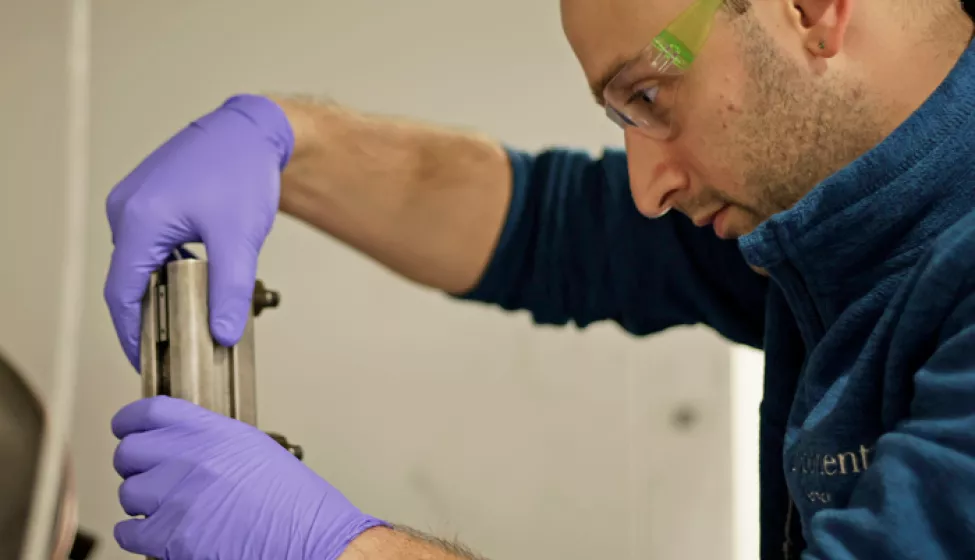July 23, 2020
Root-cause failure analysis of lithium-ion batteries provides important feedback for cell design, manufacturing, and use. As batteries are being produced with larger form factors and higher energy densities, failure analysis techniques must be adapted to characteristics of the specific batteries.
Traditional Methodology
Failure analysis of so-called "thermal" lithium-ion batteries involves an outside-in approach. The methodology, as first published in 20071 and refined over subsequent years,2,3 involves evaluating the electronics for possible component failures or propagating circuit board faults. After ruling out such factors, the focus shifts to potential external short-circuit pathways and evidence of any such pathways operating before or during the failure. If such pathways are ruled out, then the cell internals are evaluated to identify the most likely initiating cell(s) followed by the initial internal short-circuit (fault) location.
In identifying an internal short location, one of the most telling features is the presence of a location of melted and resolidified copper on the negative electrode's copper foil current collector. Traditionally, such as in thermal failures of handheld consumer electronic devices, melted and resolidified copper is only identified in select locations. Accordingly, comparing the identified location in the thermal cell to the construction of exemplar cells or abuse/recreation testing of such cells can often enable the interpretation of the presence of melted copper toward an ultimate determination of root cause.
Evolving Technology Requires an Evolving Methodology
With recent advancements to increase cell energy densities and a recent increase in demand for larger-format cells for electric vehicles and stationary storage, Exponent has begun to observe the presence of widespread melted and resolidified copper in lithium-ion batteries that have experienced thermal runaway. Our understanding is that the global temperature within the cell experiencing thermal runaway is still below the melting point of copper (~1,083°C), but it is hotter than in earlier lithium-ion battery cell designs such that secondary internal short circuits can more readily exceed the melting point of copper. In addition, the internal impedance in current designs is lower than in the past such that higher-power shorts can occur that result in more significant localized i2R heating. For example, CT images of a new cell externally heated to force cell thermal runaway are shown in Figure 1.
As shown in this figure, melted and resolidified copper is both widespread and in significantly disparate locations. This is different from copper melting associated with a localized short circuit, where such melting is generally expected to be isolated to a single location or region within the initiating cell and is typically constrained to a few immediately adjacent electrode windings/layers. In contrast, the volume of melting regions in Figure 1 occupies dozens of layers of electrode, and this is observed at multiple locations within the cell. As such, the implications of the presence of melted copper are more difficult to interpret.
Nonetheless, performing root-cause failure analysis is more important than ever with these higher-energy-density and larger-form-factor cells because of their widespread deployment and their potential for higher-energy failures. To meet this emerging challenge, Exponent is developing a new methodology to differentiate between melted copper at initiation locations versus follow-up locations in these cells. For example, Exponent's initial analysis indicates the physical appearance of the electrode around the edges of the melted copper could point to possible initiation locations. Catastrophic internal shorting events may occur quickly and violently, resulting in molten-metal spatter and localized discoloration of the copper foil associated with heating. Areas of copper that melt after the initial shorting event, due to the general thermal runaway reaction, may appear less energetic. The beading at the edge of the copper at these secondary locations could appear more uniform, with an absence of molten-metal spatter. Figure 2 shows a comparison of regions of melted and resolidified copper in a lithium-ion battery cell that is believed to have experienced an internal cell fault. A suspected initiation location is identified by melted and resolidified copper with apparent molten-metal spatter and discoloration, features that are absent in a suspected follow-up location.
How Exponent Can Help
Exponent is uniquely positioned to continually evolve its approach to root-cause analysis of lithium-ion battery failures with a multi-disciplinary team, including experts in materials science, chemistry, and chemical, mechanical, and electrical engineering.
References
- Mikolajczak CJ, Hayes TA, Megerle MV, Wu M. A scientific methodology for investigation of a lithium ion battery failure. IEEE Portable 2007 International Conference on Portable Information Devices, IEEE No. 1-4244-1039-8/07, Orlando, FL, March 2007.
- Mikolajczak C, Harmon J, Hayes T, Megerle M, White K, Horn Q, Wu M. Li-ion battery cell failure analysis: The significance of surviving features on copper current collectors in cells that have experienced thermal runaway. Proceedings, 25th International Battery Seminar & Exhibit for Primary & Secondary Batteries, Small Fuel Cells, and Other Technologies, Fort Lauderdale, FL, March 17 — 20, 2008.
- Horn Q, Hayes T, Slee D, White K, Harmon J, Godithi R, Wu M, Megerle M, Singh S, Mikolajczak C. Methodologies for battery failure analysis. In: Handbook of Batteries, Fourth Edition. Thomas Reddy (ed), McGraw-Hill, October 2010.

